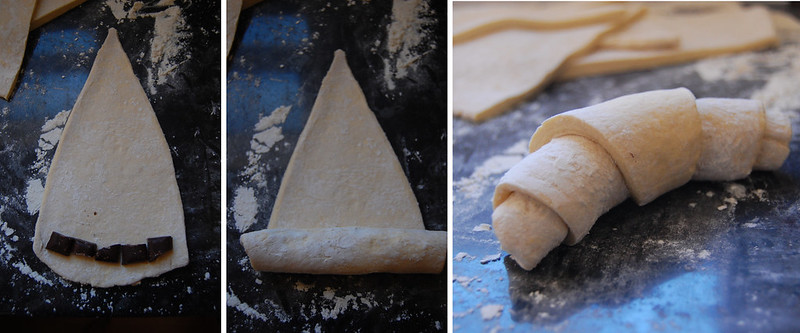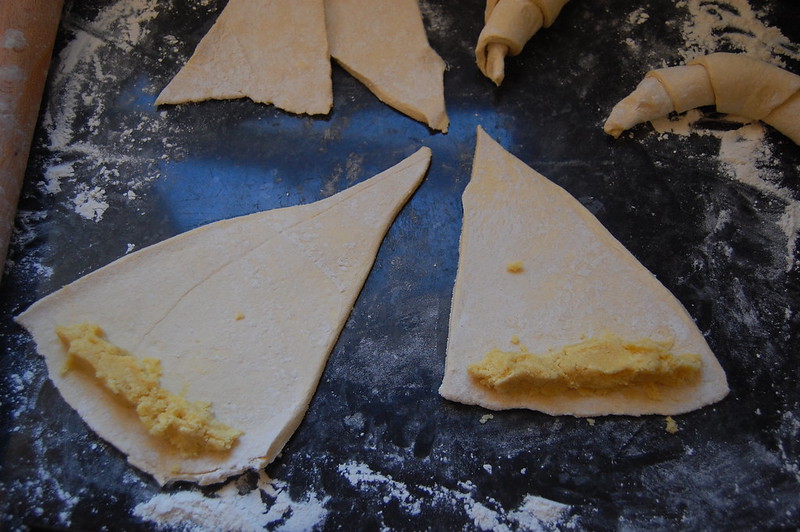So we first published our croissants recipe a while ago but I've been making croissants every 5 weeks or so for the last two years. I've picked up a few more hints and tips and thought I'd share them. I've taken many, many photos along the way to try to help you enjoy these tasty croissants at home. I've also been experimenting with fillings (why have croissants when you could have chocolate croissants, almond croissants, hazelnut croissants...)
Believe it or not, this recipe is vegan. No 'all butter' labels here. You do need a butter/hard fat substitute. I get mine from Sainsbury's but I've found some at Lidl too.
Anyway, first things first. This is not a quick win. If you want to make croissants, start early. Like a few days in advance. It's not that they are difficult to make, you just can't rush some things. They take time. If you're concerned you may get a craving for croissants then I suggest you make a batch, cook them then freeze any leftovers. I make 10 at a time, cook them altogether then freeze that 8 that aren't eaten. I've done some highly scientific tests and decided that it's best to cook then freeze rather than freeze the raw croissants and either cook straight from frozen or defrost then cook. Cook first. Then freeze. Winner.
On to fillings. Chocolate is now non-negotiable. When I make croissants, some need to contain chocolate. With the rest, I alternate between almond (making a paste of ground almonds, sugar and Vitalite/dairy free spread) or hazelnut (much the same as almond but using toasted, chopped hazelnuts instead of almonds). You could leave them plain, I guess.
So, let's begin. This recipe makes 10 croissants.
Ingredients
- 300g strong white bread flour
- 2 tsp salt
- 30g caster sugar
- 2.5 tsp dried yeast
- 250g margarine (hard fat/baking block)
- chocolate (optional)
- 75g ground almonds (optional)
- 75g hazelnuts, toasted then chopped (optional)
- Non-dairy margarine (optional)
- 75g additional caster sugar (optional)
1. Mix the bread flour, salt, sugar, yeast with enough warm water to form a soft dough (around 150 to 200ml). Knead the dough until it becomes elastic. Place in a bowl, pour over a little vegetable oil, cover and put in the fridge for about an hour. The dough should double in size.

2. Flatten your fat, bashing it between some greaseproof paper until it's only a couple of centimetres (one inch) thick. Roll the dough into a large rectangle. Place the flattened fat into the middle and fold the dough around the fat to make a dough-y envelope. Cover then place back into the fridge and chill for another hour.

3. Roll the dough out into a large rectangle once again. It's time to fold again, this time working in as many folds as possible. I like to fold the long sides into the middle then fold this over on itself 3 or 4 times (see the photo, it'll make more sense). Put back in the fridge for at least 30 minutes.

4. Repeat step 3 two more times returning to the fridge in between each time.
5. Leave in the fridge for between 8 and 24. This is crucial. You can't rush this.
6. Take the dough out of the fridge and roll out. Cut the dough into 10 triangles. Now to fill and roll your croissants.

6a. For chocolate croissants, chop 3 squares dark chocolate and place along the bottom of the triangle. Roll the croissant up and curve into a crescent shape.

6b. For almond croissants, mix ground almonds together with caster sugar and Vitalite until it comes together in a paste. Spread this along the bottom of the triangle but don't go right up to the edges (else it will ooze out during cooking). Roll the croissant up and curve into a crescent shape.

6c. For hazelnut croissants, roast 75g hazelnuts in a hot oven for around 10 minutes. Remove the skins either by rubbing the hazelnuts together in a tea towel or tossing into a tupperware and shaking vigourously. Chop the skin-free hazelnuts finely and mix with sugar and Vitalite. Use this to stuff your croissants.
7. However you choose to fill your croissants, place the croissants onto two lined baking sheets and leave to prove for at least another hour (I usually leave these overnight).

8. Glaze with beaten egg or dairy-free milk then cook at 180C for 20-25 minutes until golden. Either devour straight from the oven or, if you can control youself, place some into tupperware and freeze for consumption later on.
9. To rescue the croissants from the freezer, defrost overnight, sprinkle with water then reheat in the oven, warming for 10-15 minutes in a cool-ish oven (around 150C).



